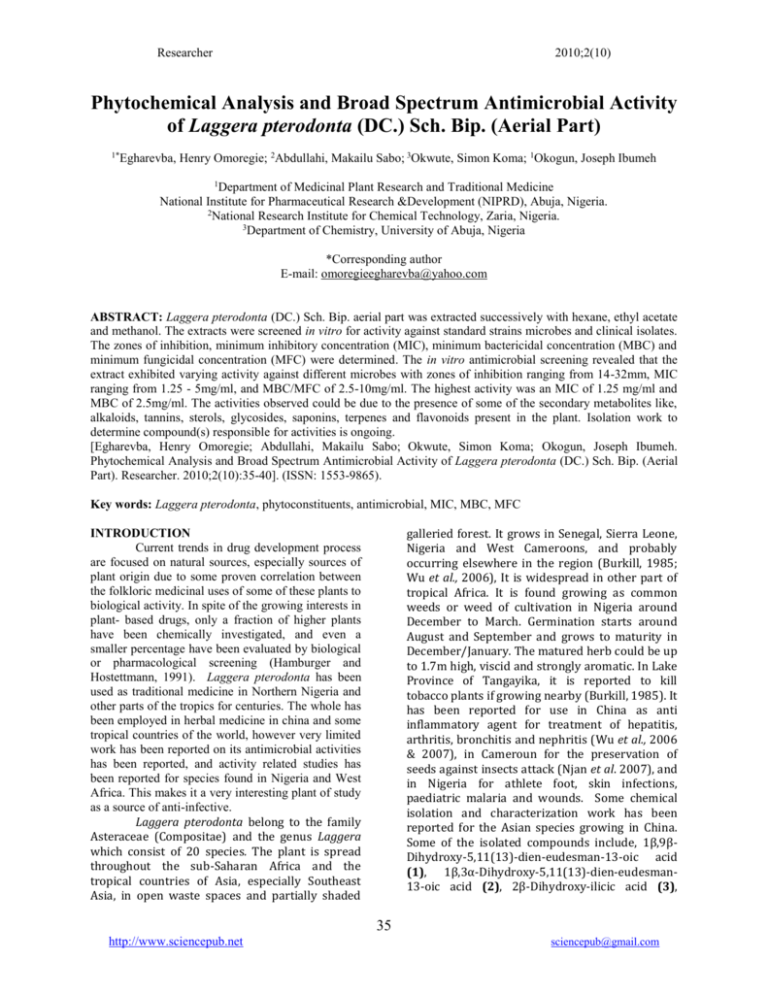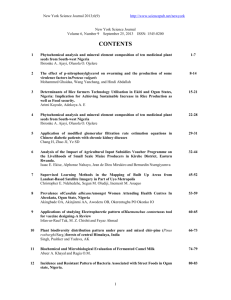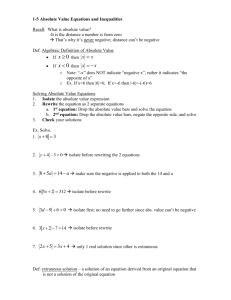Phytochemical Analysis and Broad Spectrum Antimicrobial Activity
advertisement

Researcher 2010;2(10) Phytochemical Analysis and Broad Spectrum Antimicrobial Activity of Laggera pterodonta (DC.) Sch. Bip. (Aerial Part) 1* Egharevba, Henry Omoregie; 2Abdullahi, Makailu Sabo; 3Okwute, Simon Koma; 1Okogun, Joseph Ibumeh 1 Department of Medicinal Plant Research and Traditional Medicine National Institute for Pharmaceutical Research &Development (NIPRD), Abuja, Nigeria. 2 National Research Institute for Chemical Technology, Zaria, Nigeria. 3 Department of Chemistry, University of Abuja, Nigeria *Corresponding author E-mail: omoregieegharevba@yahoo.com ABSTRACT: Laggera pterodonta (DC.) Sch. Bip. aerial part was extracted successively with hexane, ethyl acetate and methanol. The extracts were screened in vitro for activity against standard strains microbes and clinical isolates. The zones of inhibition, minimum inhibitory concentration (MIC), minimum bactericidal concentration (MBC) and minimum fungicidal concentration (MFC) were determined. The in vitro antimicrobial screening revealed that the extract exhibited varying activity against different microbes with zones of inhibition ranging from 14-32mm, MIC ranging from 1.25 - 5mg/ml, and MBC/MFC of 2.5-10mg/ml. The highest activity was an MIC of 1.25 mg/ml and MBC of 2.5mg/ml. The activities observed could be due to the presence of some of the secondary metabolites like, alkaloids, tannins, sterols, glycosides, saponins, terpenes and flavonoids present in the plant. Isolation work to determine compound(s) responsible for activities is ongoing. [Egharevba, Henry Omoregie; Abdullahi, Makailu Sabo; Okwute, Simon Koma; Okogun, Joseph Ibumeh. Phytochemical Analysis and Broad Spectrum Antimicrobial Activity of Laggera pterodonta (DC.) Sch. Bip. (Aerial Part). Researcher. 2010;2(10):35-40]. (ISSN: 1553-9865). Key words: Laggera pterodonta, phytoconstituents, antimicrobial, MIC, MBC, MFC galleried forest. It grows in Senegal, Sierra Leone, Nigeria and West Cameroons, and probably occurring elsewhere in the region (Burkill, 1985; Wu et al., 2006), It is widespread in other part of tropical Africa. It is found growing as common weeds or weed of cultivation in Nigeria around December to March. Germination starts around August and September and grows to maturity in December/January. The matured herb could be up to 1.7m high, viscid and strongly aromatic. In Lake Province of Tangayika, it is reported to kill tobacco plants if growing nearby (Burkill, 1985). It has been reported for use in China as anti inflammatory agent for treatment of hepatitis, arthritis, bronchitis and nephritis (Wu et al., 2006 & 2007), in Cameroun for the preservation of seeds against insects attack (Njan et al. 2007), and in Nigeria for athlete foot, skin infections, paediatric malaria and wounds. Some chemical isolation and characterization work has been reported for the Asian species growing in China. Some of the isolated compounds include, 1β,9βDihydroxy-5,11(13)-dien-eudesman-13-oic acid (1), 1β,3α-Dihydroxy-5,11(13)-dien-eudesman13-oic acid (2), 2β-Dihydroxy-ilicic acid (3), INTRODUCTION Current trends in drug development process are focused on natural sources, especially sources of plant origin due to some proven correlation between the folkloric medicinal uses of some of these plants to biological activity. In spite of the growing interests in plant- based drugs, only a fraction of higher plants have been chemically investigated, and even a smaller percentage have been evaluated by biological or pharmacological screening (Hamburger and Hostettmann, 1991). Laggera pterodonta has been used as traditional medicine in Northern Nigeria and other parts of the tropics for centuries. The whole has been employed in herbal medicine in china and some tropical countries of the world, however very limited work has been reported on its antimicrobial activities has been reported, and activity related studies has been reported for species found in Nigeria and West Africa. This makes it a very interesting plant of study as a source of anti-infective. Laggera pterodonta belong to the family Asteraceae (Compositae) and the genus Laggera which consist of 20 species. The plant is spread throughout the sub-Saharan Africa and the tropical countries of Asia, especially Southeast Asia, in open waste spaces and partially shaded 35 http://www.sciencepub.net sciencepub@gmail.com Researcher 2010;2(10) Pterodonta A, which is 1β-hydroxy-pterodontic acid-1-O-β-D-glucopyranoside (4), Pterodonta B, which is 9β-hydroxy-pterodontic acid-9-O-β-Dglucopyranoside (5). However, the folkloric use as an antiinfective has not been fully investigated especially on Nigerian species of the plant. Reports of chemical constituents of the oil from the species in Benin and Cameroon showed variation in composition (Asfaw et al., 1999 and 2000). We have earlier reported the activity of the crude methanol extract against Mycobacterium tuberculosis BCG strains (Egharevba et al., 2010). This work is aimed at investigating the antimicrobial potential of the Nigerian species with a view towards isolating some of the bioactive constituents in subsequent studies. drugs were sparfloxacin (0.2mg/ml), erythromycin (0.5mg/ml) and flouconazole (0.5mg/ml), all of sigma chemicals UK obtained from Zayo-Sigma Abuja Nigeria. Antimicrobial Screening Organism Source The organisms used include standard strains, Staphylococcus aureus NCTC 6571, Bacilluc subtilis NCTC 8236, Eschericia coli NCTC 10418, Pseudomonas aeruginosa NCTC 6750, Salmonella typhimurium ATCC 9184, Klebsiella pneumonia ATCC 10031 and Staphylococcuc aureus ATCC 13704, and clinical isolates, Staphylococcus aureus, Methicilin Resistant Staphylococcus aureus, Streptococcus pyogenes, Streptococcus faecalis, Corynebacterium ulcerans Listeria monocytogenes, Bacillus subtilis, Bacillus cereus, Escherichia coli, Klebsiella pneumonia, Klebsialla ozaenae, Proteus mirabilis, Proteus vulgaris, Pseudomonas aeruginosa, Pseudomonas flourescense, Salmonella typhimurium, Shigella dysenteriae, Aspergillus nigre, candida albicans, Microsporum gypseum and Trichophyton rubrum. The typed strains and clinical isolates were obtained from the department of medical Microbiology Ahmadu Bello University Teaching Hospital (ABUTH) and department of Pharmaceutical Microbiology, Ahmadu Bello University (ABU) Zaria, Nigeria, respectively. All the organisms were checked for purity and maintained at 4oC in slants of nutrient agar and sabouraud dextrose agar (SDA) for bacteria and fungi respectively. Well diffusion method described by Hugo and Russel (1992) was used to determine the antimicrobial activities (zone of inhibition) of the extracts against the organisms. MATERIALS AND METHODS All the solvents and reagent used in the study were of Analar grade and, unless otherwise stated, were sourced from Zayo-Sigma, Abuja, Nigeria. Collection and Extraction of Plant Material The plant was collected on the on 15 November, 2009 from Chaza village, Suleja, Niger State, Nigeria, and authenticated by the Taxonomist in the Department of Medicinal Plant Research and Traditional Medicine of the National Institute for Pharmaceutical Research and Development (NIPRD) Abuja, Nigeria. The plant was assigned a voucher specimen number NIPRD/H/6403. The roots were removed and the aerial part air-dried for two weeks, and then crushed with a mechanical grinder. The crushed plant was kept in an air-tight cellophane bag until used. The crushed material was later macerated successively for 24hrs in hexane, ethyl acetate and 98% methanol. The extracts were concentrated in rotary evaporator and allowed to dry in the hood. The solid extracts were used for phytochemical analysis and antimicrobial screening. Preparation of the Inoculums A loopful of the test organism was taken from their respective agar slants and sub-cultured into test-tubes containing nutrient broth for bacteria and sabouraud dextrose liquid for fungi. The test-tubes were incubated for 24hrs at 37oC for bacteria and for 48hrs at 30oC for the fungi. The obtained microorganisms in the broth were standardized using normal saline to obtain a population density of 108cfu/ml for the bacteria. For the fungi, fungal spores were harvested after 7 days old SDA slant culture was washed with 10ml normal saline in 2% Tween 80 with the aid of glass beads to help in dispersing the spores. The spores suspension were standardized to 105cfu/ml. Phytochemical screening The presence of some secondary metabolites in the plant was determined using standard methods (Sofowora, 2008; Evans, 2002). Preparation of Extract Stock Concentration for Antimicrobial screening A test stock concentration of 10mg/ml for methanol extracts was prepared by dissolving 0.1g of extract in 10mls of distilled water in a test tube. For the ethyl acetate and hexane extracts a concentration of 10mg/ml was prepared by disolving 0.1g in 10mls of dimethyl sofoxide (DMSO). The positive control Preparation of Media 36 http://www.sciencepub.net sciencepub@gmail.com Researcher 2010;2(10) The medium was prepared according to manufacturer’s instruction (Oxoids Limited Basingstoke, Hampshire, England). 40g of Blood Agar (52g of SDA) were weighed into a conical flask 1000ml of distilled water was added and capped with a cotton wool. The media were boiled to dissolution and then sterilized at 121oC for 15mins. The media were allowed to cool to 45oC and 20ml of the sterilized medium was poured into sterile petri-dishes and allowed to cool and solidify. The plates were labeled with the test microorganism (each plate with a test microbe). The microbes were spread evenly over the surface of the medium with the aid of a glass spreader. The plates were dried at 37oC for 30mins and divided into two sets to be used for the well diffusion method and the disc diffusion method respectively. concentration which showed no turbidity in the test tube was recorded as the MIC. Minimum Bactericidal/Fungicidal Concentration Broth Dilution Method Blood and sabouraud media were prepared, sterilized at 121oC for 15mins and was poured into sterile petri-dishes and left to cool and solidify. The contents of the MIC in the serial dilution were then sub-cultured onto the media and incubated at 37oC for 24hrs and 30oC for 1-7days for bacteria and fungi respectively, and observed for colony growth. The MBC/MFC was the plate with the lowest concentration of extract and without colony growth. RESULTS The results of phytochemical screening is shown in tables 1 while that of microbial screening are as shown in table 2 below. Zone of Inhibition - Well Diffusion Method A standard cork borer of 5mm in diameter was used to cut well at the center of each inoculated plate and the agar removed from the well. 0.1ml of the text solution (extract) was then introduced into the well created at the center for each plate. The bacteria plates were incubated at 37oC for 24hrs while the fungal plates were incubated at 30oC for 17days, and observed for the zone of inhibition of growth. The zones were measured with a transparent ruler and the result recorded in millimeters. The screening was done in triplicates. Sterilized distilled water and DMSO were used as negative control. DISCUSSION The methano extract was generally the most active among the extract followed by the hexane extract. However the ethyl acetate extract exhibited good activity against three fungi speciess unlike the other two extracts which were only active against candida albicans. The extracts were differentially active against food pathogens like the Staphylococcus aureus and enteric organisms like Listeria monocytogenes, Streptococcus faecalis and pyogenes, Bacillus subtilis and Bacillus cereus, Proteus vulgaris, Salmonella typhimurium, Shigella. The observed activity may be due to the presence of some metabolites like alkaloid, saponins, flavonoids and terpenes, which are known to possess various biological activities in different organisms (Okhale et al., 2010; Sadique et al., 1987; Chukwujekwu et al., 2006; Sheeba et al., 2009). Minimum Inhibitory Concentration - Broth Dilution Method MIC of the extracts was also carried out using broth dilution method as described in Ibekwe et al, 2001. The nutrient broth and sabouraud dextrose liquid were prepared according to the manufacturer’s instruction (10ml of each broth was dispensed into separate test-tube and was sterilized at 121oC for 15mins and then allowed to cool. Two-fold serial dilutions of the extracts in the broth were made from the stock concentration of the extract to obtain 10, 5, 2.5, 1.25, 0.625 mg/ml for methanol, and 5, 2.5, 1. 25, 0.625, 0.3125 mg/ml for ethyl acetate and hexane extracts. 0.1ml of the standardized inoculums of the microbes was inoculated into the different concentrations of the extracts in the broth. The test tubes of the broth were incubated at 37 oC for 24hrs and 30oC for 1-7days for bacteria and fungi respectively and observed for turbidity. The lowest CONCLUSION The result supports the folkloric use of the plant as antimicrobial in treatment of athlete’s feet, wound and skin disease as well as in malaria. It also shows that the crude plant may be useful for the management of gastroenteritis and respiratory diseases. Work is ongoing in our laboratory to characterize and screen some compounds isolated from the plant, which are thought to be responsible for these activity. Table 1: Phytochemical Analysis 37 http://www.sciencepub.net sciencepub@gmail.com Researcher 2010;2(10) METABOLITE RESULT Carbohydrate + Tannins + Saponins - Terpenes + Sterols + Flavonoids + Alkaloids + Phenols + Volatile Oil + Resin + Balsam + Cardiac glycoside + Phlobatannins + + = present, - = not detected Table 2: Zone of Inhibition S/N TEST ORGANISM 1 Staphylococcus aureus 2 Bacillus subtilis 3 Escherichia coli 4 6 Pseudomonas aeruginosa Salmonella typhimurium Klebsiella pneumoniae 7 Staphylococcus aureus 8 Candida albicans 9 10 Staphylococcus aureus Methicilin Resistant Staph. aureua Streptococcus pyogenes Streptococcus faecalis Corynebacterium ulcerans Listeria monocytogenes 5 11 12 13 14 STRAIN S ZONES OF INHIBITION MIC MBC/MFC m 27 e 20 h 27 m 2.5 e 1.25 h 1.25 m 5 e 5 h 2.50 25 20 26 2.5 1.25 1.25 5 5 2.50 27 0 28 2.5 - 1.25 5 - 2.50 30 0 27 1.25 - 1.25 5 - 5.00 24 24 24 2.5 1.25 1.25 5 5 5.00 25 27 27 2.5 1.25 1.25 5 2.5 2.50 27 22 27 2.5 1.25 1.25 10 5 5.00 24 0 29 2.5 - 1.25 5 - 2.50 30 32 26 25 22 0 1.25 1.25 1.25 1.25 1.25 - 2.5 2.5 2.5 2.5 5.00 - Isolate Isolate Isolate 30 24 27 26 27 0 27 26 27 1.25 2.5 2.5 1.25 1.25 - 1.25 1.25 1.25 2.5 5 5 2.5 2.5 - 2.50 2.50 2.50 Isolate 29 23 25 2.5 1.25 1.25 5 5 2.50 NCTC 6571 NCTC 8236 NCTC 10418 NCTC 6750 ATCC 9184 ATCC 10031 ATCC 13704 ATCC 10231 Isolate Isolate 38 http://www.sciencepub.net sciencepub@gmail.com Researcher 2010;2(10) 15 16 17 18 19 20 21 22 Bacillus subtilis Isolate 29 27 20 Bacillus cereus Isolate 30 24 22 Escherichia coli Isolate 27 0 25 Klebsiella pneumoniae Isolate 27 24 24 Klebsiella ozaenae Isolate 24 27 Proteus mirabilis Isolate 0 24 Proteus vulgaris Isolate 27 24 25 Pseudomonas Isolate 24 0 0 aeruginosa 23 Pseudomonas Isolate 30 0 0 flourescenses 24 Salmonella Isolate 22 27 24 typhimurium 25 Shigella dysenteriae Isolate 27 28 27 26 Aspergillus flavus Isolate 0 0 0 27 Aspergillus nigre Isolate 0 0 0 28 Candida albicans Isolate 17 24 25 29 Microsporum gypseum Isolate 0 18 0 30 Trichophyton rubrum Isolate 0 14 0 m= methanol extract; e= ethylacetate extract; h= hexane extract 2.5 1.25 2.5 2.5 2.5 2.5 2.5 1.25 1.25 1.25 1.25 - 1.25 1.25 1.25 1.25 1.25 1.25 1.25 - 5 2.5 5 5 5 5 5 2.5 5 5 5 - 5.00 5.00 5.00 5.00 2.50 5.00 2.50 - 1.25 - - 2.5 - - 2.5 1.25 1.25 5 2.5 2.50 2.5 5 - 1.25 1.25 - 1.25 1.25 - 5 10 - 2.5 5 - 2.50 2.50 - SOME REPORTED COMPOUNDS FROM THE SPECIES IN CHINA R1 14 1 9 2 3 R3 10 5 4 6 8 7 12 11 COOH (1). R1=R3=OH, R2=H (2). R1=R2=OH, R3=H (4). R1=O-β-D-Glc, R2=R3=H (5). R1=R2=H, R3= O-β-D-Glc R2 15 13 14 HO Compounds 1,2,4,5 1 9 2 3 10 5 6 4 HO 8 7 12 11 COOH 13 (3) National Institute for Pharmaceutical Research and Development (NIPRD) Idu, PMB 21 Garki, Abuja, Nigeria Tel. +234-803-645-3033 Email: omoregieegharevba@yahoo.com ACKNOWLEDGEMENT The authors are grateful to the management of the National Institute of Pharmaceutical Research and Development (NIPRD) and staff of the department of Medicinal Plant Research and Traditional Medicine for their supports. REFERENCES 1. Hamburger M and Hostettmann K (1991). ‘Bioactivity in plants. The link between CORRESPONDENCE Egharevba, Henry O. 39 http://www.sciencepub.net sciencepub@gmail.com Researcher 2. 3. 4. 5. 6. 7. 8. 2010;2(10) phytochemistry and medicine.’ Phytochemistry, 30(12): 3864-74. Burkill HM (1985). The Useful Plants of West Tropical Africal. Vol. 1, Families A-D. Royal Botanic Gardens Kew, pp 479-481. Egharevba, H.O., Peters, O., Okhale, S.E., Iliya, I., Kunle, F.O., Okwute, S.K. and Okogun, J.I. (2010). Preliminary AntiTuberculosis Screening of Two Nigerian Laggera Species (Laggera pterodonta and Laggera aurita). J. Med. Plant Res., 4(12), pp. 1235-1237. Asfaw N, Staresund HJ, Skattebol L. and Aasen AJ (2001) Coexistence of chrysanthenone, filifolone and (Z)isogeranic acid in the hydrodistillates. Artefacts. Phytochemistry, 58: 489-492. Asfaw N, Staresund HJ, Skattebol L. and Aasen AJ (1999). (1S,5R)-(-)-2,4,4Trimethylbicyclo [3.1.1]hept-2-en-6-one, from the essential oil of the Ethiopian plant Laggera tomentosa. Phytochemistry, 52: 1491-1494. Njan Nlôga AM, Saotoing P, Tchouankeu JC and Messi J (2007), Effect of Essential Oils of Six Local Plants Used Insecticide on Adults of Anopheles gambiae, Giles 1902. Journal of Entomology, 4 (6):444-450. Wu Y, Wang F, Zheng Q, Lu L, Yao H, Zhou C, Wu X and Zhao Y (2006), Hepatoprotective effect of total flavonoids from Laggera alata against carbon tetrachloride-induced injury in primary cultured neonatal rat hepatocytes and in rats with hepatic damage. Journal of Biomedical Science, 13: 569-578. Wu Y, Yang L, Wang F, Wu X, Zhou C, Shi S, Moban J, Zhao Y (2007) Hepatoprotective and antioxidative effects of total phenolics from Laggera pterodonta 9. 10. 11. 12. 13. 14. 15. 16. on chemical-induced injury in primary cultured neonatal rat hepatocytes. Food and Chemical Toxicology, 45(8): 1349-1355. Okhale, S.E., Odiniya, E.O., and Kunle, O.F. (2010). Preliminary Phytochemical and Pharmacognostical Investigation of Pediatrics Antimalarial Laggera pterodonta (DC) Sch. Bip.: Asteraceae of Nigerian Origin. Ethnobotanical Leaflets, 14: 457-66. Sofowora A (2008). Medicinal Plants and Traditional Medicine in Africa. 3rd Edn., Spectrum Books Limited Ibadan, Nigeria, pp: 199-204. Evans W.C. (2002). Trease and Evans Pharmacognosy. 15th Edition, Elsevier India, pp 137-393. Hugo, W.B. and Rusell, A.D., (1992). Pharmaceutical Microbiology 5th ed. Blackwell Scientific Publication, Oxford London, pp. 258-297. Bauer, A.N., Kirby, W.W., Sherris, I.C. and Turck, N. (1960). Antibiotics susceptibility test by a standardized single disc method. American Journal of Clinical Pathology, 45:493-496. Ibekwe, V.I., Nnanyere, N.F. and Akujobi, C.O. (2001). Studies on Antibacterial Activity and Phytochemical qualities of Extracts of Orange peels. Int. J. Environ. Health and Human Dev., 2(1):41-46. Chukwujekwu JC, Coombes PH, Mulholland DA and van Staden J (2006) Emodin, an antibacterial anthraquinone from the roots of Cassia occidentalis. South African Journal of Botany, 72(2): 295-297. Sheeba M, Emmanuel S, Revathi K and Ignacimuthu S (2009). Wound healing activity of Cassia occidentalis L. in Albino Wistar rats. IJIB , 8(1):1-6. Manuscript submission date: 20th September 2010. 40 http://www.sciencepub.net sciencepub@gmail.com







